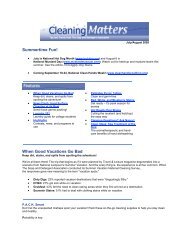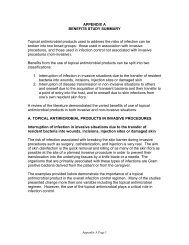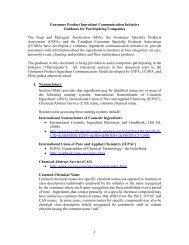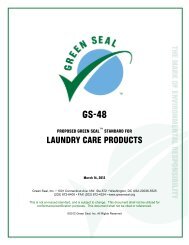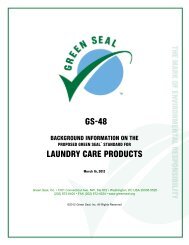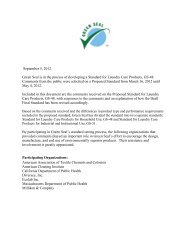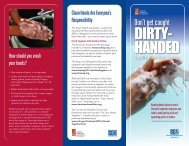subchapter c -- federal hazardous substances act regulations
subchapter c -- federal hazardous substances act regulations
subchapter c -- federal hazardous substances act regulations
Create successful ePaper yourself
Turn your PDF publications into a flip-book with our unique Google optimized e-Paper software.
prevent the knot from slipping out or untying<br />
in use.<br />
(ii) The toy shall be tested at the time of<br />
production:<br />
(A) By using the sampling procedure<br />
described in the table in subdivision (vi) of<br />
this subparagraph to determine the number of<br />
units to be tested.<br />
(B) By subjecting each ball tested to 10<br />
drops of a 2.25 kg (5-pound) steel imp<strong>act</strong> rod<br />
or weight (57-mm (21⁄4-inch) diameter with a<br />
flat head) dropped 1220 mm (48 inches) in a<br />
vented steel or aluminum tube (60-mm (2 3 ⁄ 8 -<br />
inch) inside diameter) when the ball is placed<br />
on a steel or cast iron mount. Clacker balls<br />
where the mass of each ball is less than 12<br />
grams (0.42 oz.) and the distance between the<br />
center of the pivot and the center of the ball<br />
cannot exceed 180 mm (7.1 inches) may be<br />
tested by dropping the imp<strong>act</strong> weight from a<br />
height of less than 1220 mm (48 in.), where<br />
the height is computed as follows:<br />
Adjusted drop height in mm=179×10 -5 (mb)<br />
(Rp2), where mb=mass of a single ball in<br />
grams and<br />
Rp=pivot length in mm.<br />
Any ball showing any chipping, cracking, or<br />
shattering shall be counted as a failure within<br />
the meaning of the third column of the table in<br />
paragraph (a)(5)(vi) of this section.<br />
(C) By inspecting each ball tested for<br />
smoothness of finish on any surface of the ball<br />
which may come in cont<strong>act</strong> with the cord<br />
during use. A cotton swab shall be rubbed<br />
vigorously over each such surface or area of<br />
the ball; if any cotton fibers are removed, the<br />
ball shall be counted as a failure within the<br />
meaning of the fourth column of the table in<br />
subdivision (vi) of this paragraph. The toy<br />
shall also be checked to ascertain that there is<br />
no visibly perceptible “wicking up” or<br />
“running up” of the casting resins on the<br />
outside of the cord in the vicinity where the<br />
ball is attached.<br />
(D) By fully assembling the toy and testing<br />
the cord in such a manner as to test both the<br />
strength of the cord and the adequacy with<br />
which the cord is attached to the ball and any<br />
holding device such as a tab or ring included<br />
in the assembly. The fully assembled article<br />
shall be vertically suspended by one ball and a<br />
445-Newton (100-pound) test applied to the<br />
16 CFR Ch. II (1–1–05 Edition)—proposed modificication – 6/25/06<br />
-- 75 --<br />
bottom ball. Clacker balls where the mass of<br />
each ball is less than 12 grams (0.42 oz.) and<br />
the distance between the center of the pivot<br />
and the center of the ball cannot exceed 180<br />
mm (7.1 inches) may be tested with a force of<br />
under 445 Newtons (100 pounds). The test<br />
force for these clacker balls shall be the same<br />
as the cord breaking strength calculated in §<br />
1500.86(a)(5)(i)(B). Any breaking, fraying, or<br />
unraveling of the cord or any sign of slipping,<br />
loosening, or unfastening shall be counted as a<br />
failure within the meaning of the fourth<br />
column of the table in paragraph (a)(5)(vi) of<br />
this section.<br />
(E) By additionally subjecting any ring or<br />
other holding device to a 222-Newton (50-<br />
pound) test load applied to both cords; the<br />
holding device is to be securely fixed<br />
horizontally in a suitable clamp in such a<br />
manner as to support 50 percent of the area of<br />
such holding device and the balls are<br />
suspended freely. Clacker balls where the<br />
mass of each ball is less than 12 grams (0.42<br />
oz.) and the distance between the center of the<br />
pivot and the center of the ball cannot exceed<br />
180 mm (7.1 inches) may have their holding<br />
device tested with a force of less than 222<br />
Newtons (50 pounds). The holding device test<br />
force for these clacker balls shall be half of the<br />
cord breaking strength calculated in §<br />
1500.86(a)(5)(i)(B). Any breaking, cracking,<br />
or crazing of the ring or other holding device<br />
shall be counted as a failure within the<br />
meaning of the fourth column of the table in<br />
paragraph (a)(5)(vi) of this section.<br />
(F) By cutting each ball tested in half and<br />
then cutting each half perpendicularly to the<br />
first cut into three or more pieces of<br />
approximately equal thickness. Each portion is<br />
to be inspected before and after cutting, and<br />
any ball showing any flash, crack, crazing, or<br />
internal voids on such inspection is to be<br />
counted as a failure within the meaning of the<br />
fourth column of the table in paragraph<br />
(a)(5)(vi) of this section. Balls that are<br />
injection-molded and possess high-imp<strong>act</strong><br />
char<strong>act</strong>eristics (such as injection-molded balls<br />
made of ABS, nylon, or high-imp<strong>act</strong><br />
polystyrene) though exempt from the<br />
requirements that there be no internal voids,<br />
must be tested to determine the presence of<br />
any flash, crack or grazing. A transparent ball<br />
shall be subjected to the same requirements



